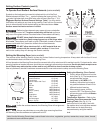
7
Setting Surface Controls
Cookware Material Types
The cookware material determines how evenly & quickly heat is transferred from the surface element to the pan bottom.
The most popular materials available are:
ALUMINUM - Excellent heat conductor. Some types of food
will cause it to darken (Anodized aluminum cookware resists
staining & pitting). If aluminum pans slide across the ceramic
cooktop, they may leave metal marks which will resemble
scratches. Remove these marks immediately.
COPPER - Excellent heat conductor but discolors easily.
May leave metal marks on ceramic glass (see Aluminum).
STAINLESS STEEL - Slow heat conductor with uneven
cooking results. Is durable, easy to clean & resists
staining.
CAST IRON - A poor heat conductor however will retain
heat very well. Cooks evenly once cooking temperature is
reached. Not recommended for use on ceramic cooktops.
PORCELAIN-ENAMEL on METAL - Heating
characteristics will vary depending on base material.
Porcelain-enamel coating must be smooth to avoid
scratching ceramic cooktops.
GLASS - Slow heat conductor. Not recommended for
ceramic cooktop surfaces because it may scratch the
glass.
About the Ceramic Glass Cooktop
The ceramic cooktop has radiant surface elements located below the surface of the glass. The design of the ceramic
cooktop outlines the area of the surface element underneath. Be sure to match the pan size with the diameter of the
element outline on the cooktop. Heat is transferred up through the surface of the cooktop to the cookware. Only flat-
bottomed cookware should be used.
The type and size of cookware, the number of surface elements in use and their settings, are all factors that will affect the
amount of heat that will spread to areas beyond the surface elements. The areas surrounding the elements may become
hot enough to cause burns.
Using proper cookware
Fig. 2
The size and type of cookware used will influence the setting
needed for best cooking results. Cookware should have flat
bottoms that make good contact with the entire surface
heating element (See Fig. 2). Check for flatness by rotating a
ruler across the bottom of the cookware (See Fig. 1).
Be sure to follow the
recommendations for using
proper cookware as
illustrated in Figs. 1 & 2.
For more information about
the ceramic cooktop see
Cooktop Cleaning &
Maintenance in the
General Care & Cleaning
section.
Fig. 1
The suggested settings found in Fig. 3 are
based when cooking with medium-weight
aluminum pans with lids. Settings may vary
when using other types of pans.
Suggested Radiant Surface Element Settings Table
Fig. 3
Note: The size and type of utensil used, and
the amount and type of food being cooked will
influence the setting needed for best cooking
results.
SINGLE & DUAL RADIANT SURFACE ELEMENTS
Setting Type of Cooking
HIGH (HI - 9) Start most foods, bring water to a boil, pan broiling
MEDIUM HIGH (7 - 8) Continue a rapid boil, fry, deep fat fry
MEDIUM (5 - 6) Maintain a slow boil, thicken sauces and gravies or
steam vegetables
MEDIUM LOW (2 - 4) Keep foods cooking, poach, stew
LOW (LO - 1) Keep warm, melt, simmer


















